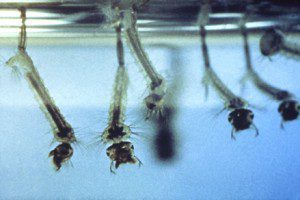Worried About Mosquitoes?
By Chris Williams on March 31, 2016.
With all the news about Zika virus showing up in the U.S., I’m starting to freak out about the upcoming mosquito season. We’ve always had a bit of a mosquito problem on our property. Our neighborhood sprays but I know that’s not totally effective. What else should we do? F. L., Marblehead, MA

Mosquito larvae
Hopefully you understand mosquito biology and a bit about how mosquitoes develop in standing water – but I’m always amazed at the number of people who know nothing about where mosquitoes come from.
I once dealt with a family who were blaming their mosquitoes on their neighbors’ unused and quite scummy swimming pool. Turns out the swimming pool was not breeding mosquitoes since it actually contained hungry frogs. Instead, I discovered that the yard of the complainants was full of tires, buckets, and other containers that all had developing mosquito larvae. In other words, these people didn’t realize that they were their own worst enemy!
You Can Eliminate Mosquito Breeding Sites in Your Yard
All mosquito larvae develop in standing water and it doesn’t take a lot. Development from egg to adult mosquito, for most species, can take as little as 7 days so if water remains available for that long, biting mosquitoes can emerge. Some mosquitoes lay their eggs directly in stagnant standing water in tree holes or various containers, others lay their eggs in areas that are dry but due to be flooded when it next rains or when snow melts. See It’s Not Too Early for Mosquitoes!
Do yourself and your family a favor now before the weather gets warm by conducting a mosquito survey of your yard, looking for potential mosquito breeding sites:
- Make sure you know what developing mosquito larvae and pupae look like. The larvae hang from the water’s surface unless they are disturbed, when they dive to the bottom.
- Look for and empty any type of container that will hold rainwater such as buckets, cans, tires, wheelbarrows, plant pots and saucers, wading pools, canoes, sand boxes, pet bowls, garbage cans, and so on. In fact, this can be a fun assignment for kids. Turn it into a game to see who can find the most things that can hold water.
- If you find containers that are not currently holding water, assume that they eventually will and store them inside or turn them upside down. Cover larger items that could collect water with tarps or plastic sheets but make sure that you don’t leave depressions in the cover that could hold water, too.
- If you have areas in your yard where water stands, make the effort now to regrade, drain, or fill low spots to eliminate puddles later.
- Clean and repair roof gutters and downspouts. Make sure splash blocks are in place to direct runoff from downspouts.
Photo Credit : Source: EPA